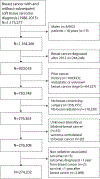Incidence of radiation-associated sarcoma after breast-conserving surgery plus radiation
- PMID: 36477419
- PMCID: PMC11760338
- DOI: 10.1002/jso.27167
Incidence of radiation-associated sarcoma after breast-conserving surgery plus radiation
Abstract
Background: Radiation-associated sarcoma (RAS) is a rare sequela of radiotherapy. Radiotherapy modalities for breast conservation and radiation treatment (BCT) have changed over time. We sought to determine if the incidence of RAS after BCT has changed over time.
Methods: We identified breast cancer survivors (diagnosed 1988-2012) treated with BCT within the SEER database. We excluded patients with prior cancer, <1-year follow-up/survival, and nonexternal beam radiation (n = 276 301). We identified patients with a subsequent chest sarcoma diagnosis. The primary predictor variable was a 5-year period of breast cancer diagnosis year (1988-1992, 1993-1997, etc.). The incidence of sarcoma was estimated by the Kaplan-Meier method, censoring at sarcoma diagnosis, death, or last follow-up (available through December 2017). Given the known latency of RAS, we used Joinpoint analysis to identify the time point at which RAS incidence significantly increased (start of the analytic window). A log-rank test assessed differences in RAS incidence by diagnosis year.
Results: The incidence of RAS was 0.03% at 5 years (95% confidence interval [CI]: 0.03-0.04) and 0.16% at 10 years (95% CI: 0.14-0.18). No statistical difference in RAS incidence by diagnosis year was observed (p = 0.2).
Conclusions: RAS remains a rare but persistent sequela after BCT. As new radiation modalities become more common, ongoing surveillance is necessary to track these rare events.
Keywords: neoplasms, radiation induced; soft tissue neoplasms.
© 2022 Wiley Periodicals LLC.
Figures
Similar articles
-
Radiation-associated sarcoma after breast cancer in a nationwide population: Increasing risk of angiosarcoma.Cancer Med. 2018 Sep;7(9):4825-4835. doi: 10.1002/cam4.1698. Epub 2018 Jul 25. Cancer Med. 2018. PMID: 30044058 Free PMC article.
-
Equivalent Survival With Mastectomy or Breast-conserving Surgery Plus Radiation in Young Women Aged < 40 Years With Early-Stage Breast Cancer: A National Registry-based Stage-by-Stage Comparison.Clin Breast Cancer. 2015 Oct;15(5):390-7. doi: 10.1016/j.clbc.2015.03.012. Epub 2015 Apr 2. Clin Breast Cancer. 2015. PMID: 25957740 Free PMC article.
-
Sarcoma as a second malignancy after treatment for breast cancer.Int J Radiat Oncol Biol Phys. 2002 Apr 1;52(5):1231-7. doi: 10.1016/s0360-3016(01)02799-7. Int J Radiat Oncol Biol Phys. 2002. PMID: 11955733
-
Post-irradiation angiosarcoma of the breast: clinical presentation and outcome in a series of six cases.Breast Cancer Res Treat. 2015 Aug;153(1):3-8. doi: 10.1007/s10549-015-3506-0. Epub 2015 Jul 24. Breast Cancer Res Treat. 2015. PMID: 26206321 Review.
-
Is the breast-conserving treatment with radiotherapy appropriate in BRCA1/2 mutation carriers? Long-term results and review of the literature.Breast Cancer Res Treat. 2010 Feb;120(1):119-26. doi: 10.1007/s10549-009-0685-6. Epub 2009 Dec 24. Breast Cancer Res Treat. 2010. PMID: 20033769 Review.
Cited by
-
A retrospective external validation study of the Birmingham Atypical Cartilage Tumour Imaging Protocol (BACTIP) for the management of solitary central cartilage tumours of the proximal humerus and around the knee.Eur Radiol. 2024 Aug;34(8):4988-5006. doi: 10.1007/s00330-024-10604-y. Epub 2024 Feb 6. Eur Radiol. 2024. PMID: 38319428
References
-
- Miller KD, Nogueira L, Mariotto AB, Rowland JH, Yabroff KR, Alfano CM, et al. Cancer treatment and survivorship statistics, 2019. CA Cancer J Clin. 2019;69:363–85. - PubMed
-
- Cahan WG, Woodard HQ, Higinbotham NL, Stewart FW, Coley BL. Sarcoma arising in irradiated bone: report of eleven cases. 1948. Cancer. 1998;82:8–34. - PubMed
-
- Kirova YM, Vilcoq JR, Asselain B, Sastre-Garau X, Fourquet A. Radiation-induced sarcomas after radiotherapy for breast carcinoma: A large-scale single-institution review. Cancer. 2005;104:856–63. - PubMed
-
- Pierce SM, Recht A, Lingos TI, Abner A, Vicini F, Silver B, et al. Long-term radiation complications following conservative surgery (CS) and radiation therapy (RT) in patients with early stage breast cancer. Int J Radiat Oncol Biol Phys. 1992;23:915–23. - PubMed
MeSH terms
Grants and funding
LinkOut - more resources
Full Text Sources
Medical
Research Materials



